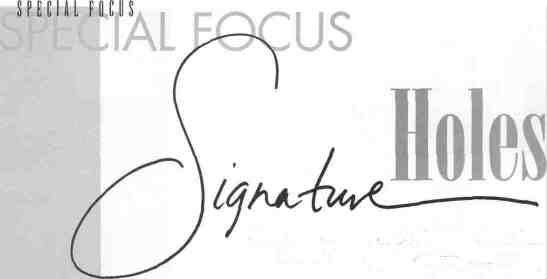
Come play a round of 18 signature holes from
Illinois' finest public courses, and see why
golfers love to play the prairie
A lot of dirt's been moved in Illinois cornfields and prairies to sculpt the beautiful and challenging golf courses operated by park districts and forest preserves. Despite our seeming lack of
unusual topography, it's known that some of the best golf courses in the nation are played right
here in the "breadbasket of America."
Rockford, in fact, was ranked by Golf Digest last year as the best golf city in the United States
(for cities of medium size) and 12th out of 309 cities of all sizes. The ranking is based on access to
good, affordable public and municipal golf. For the record, Bloomington came in at number 13
and Decatur at 18. And, there's no space here to list all the high ranks awarded the golfers' havens
located throughout Chicagoland. (See Public Course Guide '99 on p. 41.)
So what we've done for you on the following pages is provided an 18-hole course made from the
signature holes of Illinois' finest public courses. Ken Ledene, PGA professional and manager of the
Byron Forest Preserves Prairieview Golf Course, graciously agreed to "build" the course based on
descriptions provided by each agency's PGA professional or director.
"I tried as much as possible to put the holes in the order from a golfer's standpoint: a variety of
long holes, short holes, water holes," says Ledene. "Yardage on the front 9 would be 3,306 and
3,131 on the back nine. This is short for a championship course, but that's because we have some
pretty short par 4s represented."
But don't be fooled. Length doesn't matter. These holes have a high level of difficulty.
Adds Ledene: "A lot of these have water, an island green or pond in front of the green which
prevents you from rolling the ball up onto the green. Even a professional golfer would think twice
about carrying a ball over 250 yards in the air."
He's actually played seven of the 18 courses listed here and he plans to visit more.
"The trend is that more upper- and middle-level golfers are looking for courses that are out of
the ordinary," says Ledene. "They're willing to travel to play high quality courses designed by well-
known architects.
"The private club is becoming less popular in some ways. They become too expensive for those
people who can't make the time commitment to play regularly. Some don't want to play one
course all the time....They want to play a variety of high caliber courses like ThunderHawk."
Regarding a course's signature, Ledene says: "A lot of architects design holes with a signature
hole in mind. Some even earn a reputation for a certain signature style or feature. For example,
Pete Dye. He made using railroad ties popular....He builds elevated greens and island greens
surrounded by railroad ties."
Take a look at these signatures. Then, take a trip to each course and take a swing!
March/April 1999 27
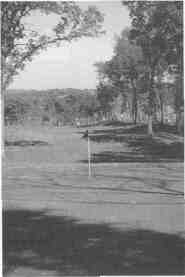
1. Heritage Bluffs Public Golf Club
Channahon Park District
24355 W. Bluff Road, Channahon
815/467-PUTT
#6 — Par 4, 413 yards
After tackling the longest par 3 on the course, golfers
at Heritage Bluffs encounter hole #6. The slender
fairway was carved out of a forest, with a thick stand
of tall pine trees lining the left side of the fairway.
The look recalls many courses in the Carolinas, with
the trees actually part of an old Christmas tree farm
that was never harvested. The right edge of the
fairway is also menacing, with hundred-year oak trees
occupying that perimeter.
While not a difficult hole to score well on, golfers
must rocket straight off the tee and then hit an
accurate second shot. Like the fairway, the narrow
green is surrounded by trees, and further protected
with mounding on the right and bunkers on the left.
A wetland area promises to swallow any shots that
sail over the green.
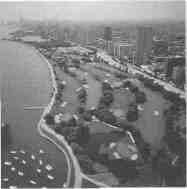
2. Sydney R. Marovifz
Chicago Park District
3600 N. Recreation Drive, Chicago
312/245-0909
#5 — Par 5, 515 yards
Lake Michigan guards the entire right side of this
gentle dogleg right, par 5 hole. Golfers will enjoy a
beautiful view the Chicago skyline and the peaceful
sounds of Lake Michigan.
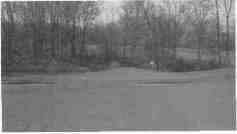
Hickory Ridge Golf Course
Carbondale Park District
2727 W. Glenn Road, Carbondale
618.529.4386
#8 — Par 3, 165 yards
Looking from the 15-foot elevated tee
at Hickory Ridge's #8, you get a scenic
view of the green as you swing. Adjust
your club selection on this short par 3
to account for the change in elevation
and pay particular attention to the
winds coming off the lake, which
surrounds the entire lefthand side of the hole. Remember, once you reach the surface all putts
break towards the water. The green is not an easy green to putt. It's a short hole that can change
dramatically in length and how the wind affects the shot. The tee is sheltered from the wind and
the green is not. Add beauty to the challenge with flowering dogwoods along the tee and beyond,
a prominent grove of large, deciduous hickory trees.
28 Illinois Parks and Recreation
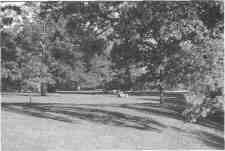
Newman Golf Course
Peoria Park District
2021 W. Nebraska Ave., Peoria
309/674-1663
#18 — Par 4, 409 yards
Majestic old oaks frame Newman's #18, a fitting end following five of the
toughest finishing holes in the area. Even Julius Boros once proclaimed
this hole one of the hardest finishing holes he had every played. The
fairway features a tree line to the left and a hazard to the right, so accuracy
off the tee is obviously the key. This 409-yard hole with a slight dogleg to
the right is challenging for all.

5. Shepherd's Crook
Zion Park District
401 N. Green Bay Road, Zion
847/746-5500
#16 — Par 3, 165 yards
Yet to be played (Shepherd's Crook opens fall 1999/
spring 2000), this is a great little hole that utilizes many
elements typical of a Keith Foster designed course. The
hole works with the land, it's a challenge to any level of
golfer and aesthetically pleasing to the eye. From an
elevated tee, and a short iron in hand, the golfer can be
lulled into a false sense of tranquility.
Proper club selection is imperative, as changing winds
can dictate anything from a nine to five iron for most
golfers. It has a large deep bunker guarding the right front
of the green and is framed by water and handsome
bunkering on the left. Take heed, for a double bogey five
is possible if the tee shot is long or left. Standing on the
tee, contemplating the shot to #16, the feelings of
anticipation, dread and excitement will fill every golfer.
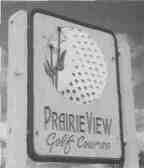
Prairieview Golf Course
Byron Forest Preserve District
7993 N. River Road, Byron
815/234-GOLF
#6 — Par 5, 540 yards
Prairieview's infamous #6 has been compared to a thrilling roller coaster ride: intermittent
moments of anxious anticipation and excitement leading up to a tortuous and thrilling climax.
Looking down the fairway, the golfer's first challenge is a gradual uphill tee shot of 220 to 250
yards into the prevailing wind. Ideally, you want to place your shot just left of the fairway at the
top of the hill. Let your tee shot stray left of right and you can start looking for it in a maze of
steep face mounds encircled by prairie grass.
Up ahead, the fairway sharply dips and begins turning slowly to the right before suddenly
disappearing into a forest of trees. Only a sliver of an opening 150 to 190 yards ahead gives any
indication where the rest of the hole and green might be hiding. No point in being greedy here. The ideal placement is left center
fairway or near or just past the 150-yard marker.
The third and most critical shot now awaits you. Looking slightly to your right and down a dark, narrow tunnel cut through thick
trees and then up to the top of a ridge, there appears a slight glimmer of a flagstick and the possibility of a green. Only 150 yards or less
and you're home at last! But something is lurking, ominously, above and in front of you: a huge oak tree branch arching over what
seems to be the entire width of this tunnel of a fairway. Only two choices left at this point: cut short iron up and over as high as you
possibly can and pray or punch down and under and try to let it roll up the side of a usually unforgiving hill.
The green putts relatively easy, except maybe for that almost impossible pin placement just behind the front right bunker or that
back, upper left comer, or maybe...
March/April 1 999 ¦ 29
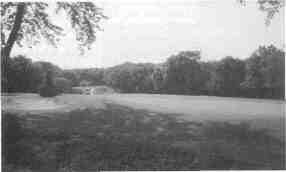
Woodruff Golf Course
Joliet Park District
621 N. Gougar Rd., Joliet
815/741-7272
#16 — Par 4, 310 yards
From the tee box, the
player is greeted by a
three-tier flower bed,
which is aesthetically
pleasing to the eye. The
fairway view offers golfers
their first view of multicolored impatients surrounding the back of the green.
The scenery provides a
view of a wide variety of
trees bordering the entire
hole. Don't be fooled by
the distance of this par 4.
It takes an extremely
accurate tee shot to enable a short iron to an elevated green. Players are faced with trees on both sides
and a creek running across the center of the fairway. Club selection on approach shots is vital. This
5,500-square-foot undulated green is well-guarded by bunkers on each side. The smart player will find
that precision is more important than power on the 16th at Woodruff, Joliet Park District's oldest
course, situated on 100 acres of land donated in 1921 by locals Mr. And Mrs. George Woodruff, who
wanted to make the game of golf available to all in Joliet.
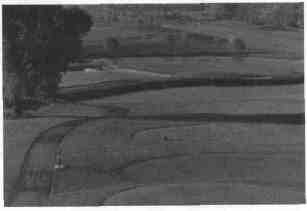
Aldeen Golf Club
Rockford Park District
1900 Reidfarm Road, Rockford
815/282-GOLF
#8 — Par 3, 203 yards
Like many of the holes
at Aldeen, this island
green was modeled
after a hole designed
for one of the best golf
courses in the world.
In #8s case, course
designer Dick Nugent
borrowed from the
17th hole at the
Tournament Players
Club at Sawgrass,
Ponte Vedra, Florida.
The island green is
completely surrounded
by water. Players access
the green from the
bridge, an exact replica of the 500-year-old bridge over Swilcan bum (brook) at St. Andrews in
Scotland. With specifications completed in Scotland and handiwork by stonemasons in Illinois, the
bridge is the capstone for the course's benefactor Norris Aldeen. As the story goes, in 1988 Aldeen, a
Rockford resident and heir to the family's Amerock Corporation hardware fortune, walked into a
Rockford Park District board meeting and said: "My mother taught me to play golf at Sinnissippi (a
-Rockford Park District golf course) and we want to leave 1 million dollars to build another course for
the Rockford community." In the end, Aldeen donated several million dollars, hired renown designer
Dick Nugent, plus donated additional funds for the bridge built in honor of his mother on hole #8.
30 ¦ Illinois Parks and Recreation
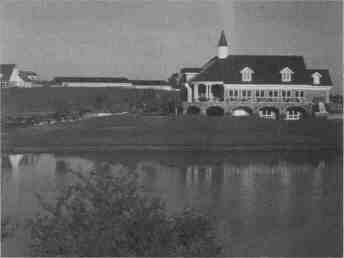
9 Steeple Chase Golf Club
Mundelein Park and Recreation District
200 LaVista Drive, Mundelein
847/949-8900
#18 — Par 5, 543 yards
Nicknamed "Drama," #18's elevated tee
affords a memorable sight of two large
natural lakes and one of the most demanding
3-shot holes in all of golf. The tee shot must
hug the wet left side, while avoiding the
temptation of the safe-looking, wide open
area down the right. A tee shot in the right
rough creates two big problems: a much
longer shot to the very narrow fairway and
pronounced sidehill lies from the rolling,
uneven terrain. The second shot, properly
laid up short of the creek, which crosses the
fairway 60 yards short of the green, must be
fit into Steeple Chase's narrowest and least
forgiving target. The third shot over the lake
with the overlooking clubhouse is unforgettable. The mounded, well-bunkered, steeply
sloped green surrenders nothing. Everything,
putts included, must be earned. Course
architect Ken Killian designed this signature
hole and other 17 distinctive holes that make
up Steeple Chase, ranked among the top 10
public courses in Chicagoland every year since opening in 1993.
10 Pottawatomie Golf Course
St. Charles Park District
845 N. Second Avenue, St. Charles
630/584-8356
#3 — Par 4, 345 yards
The third at Pottawatomie incorporates Robert Trent
Jones' early conceptualization of the heroic principle of
golf design. The tee shot need only cover 200 yards,
depending on the tee location of the day. The tee shot
seems simple and easy, but a shot too wide of the
parallel hazard produces a longer second shot over the
inlet to a small and shallow green. A tee shot too close
to the hazard risks an unnecessary penalty off the tee.
The importance of a properly played tee shot is
recognized immediately by the length of the approach
shot, usually ranging from 85 to 150 yards. The
approach shot is difficult to judge in its own right
because of the lack of elevation and its uniqueness of
its setting within the surrounding Fox River. With two
respectable shots, this hole becomes an easy par;
however, one flawed shot creates more.
11. Village Greens
Woodridge Park District
1575 75th Street, Woodridge
630/985-3621
#14 — Par 4,400 yards
This hole calls for golf course management at its finest. As
you look down the l4th fairway from the elevated tee box,
trouble lurks everywhere. A large lake looms on the right,
which progressively narrows the fairway the farther you hit
your tee shot. Out of Bounds guards the entire left side of
the hole, and a strategic bunker sits on the left side of the
fairway, 220 to 24 yards from the tee. You must carefully
weigh your options on your tee shot because this will
often make or break a round. Play conservatively with an
iron to avoid the bunker left and you will face a 200-plus-
yard approach to a green protected by water short and
right, bunkers on the left and out of bounds long. Take a
driver out and you must "thread the needle" between the
bunker and the water encroaching into the fairway. This
hole is one of the toughest par 4's in the area.
March/April 1 999 ¦ 31
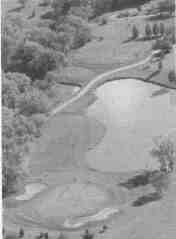
Palatine Hills Golf Course
12. Palatine Park District
512 W. Northwest Highway, Palatine
847/359-4020
#7 — Par 3, 185 yards
Wind direction and velocity along with the pin position on
a large green makes club selection a key component to
playing this hole successfully. An accurate shot to the green
is required due to the water on the left, in front of the tee
and on the right side of the entire hole. Lastly, a bunker
behind the green and on the right side of the green
contribute to a very intimidating tee shot.
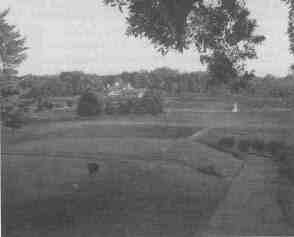
13. Scovill Golf Course
Decatur Park District
3909 W. Main Street, Decatur
217/429-6243
#18 — Par 4, 238 yards
You only have to play hole #18
to understand the variety of
strategic options available to the
golfer at Scovill, considered a
"shot-maker's course." The hole
plays from an elevated tee to a
green that is guarded in front
and to the side by a pond.
Measuring only 238 yards from
the back tee, this short par 4
gives you the exciting option to
"go for three green" on your tee
shot and risk hitting the water
hazard or layup with a middle iron.
Once you are safely in the fairway,
you still must negotiate the shot
over the water to a green that slopes
toward the water with a mound on
the left and an unusually difficult
hole location. This shot might be a
high lob to an up-front pin position
or a low, running shot to a back pin
position. Once on the green, due to
the water hazard, the ball tends to
break more than the eye can see.
This type of hole is referred to as a
"risk-reward" hole. To add to the
challenge and pressure, all shots
taken here are played under the
watchful eye of fellow golfers on the
deck of the clubhouse.
14. Winnetka Golf Club
Winnetka Park District
1300 Oak, Winnetka
847/501-2050
#9 — Par 4, 407 yards
Four quality shots will be required for a par on
this demanding front nine finisher at Winnetka
Golf Club. For the best position off the tee, the
player needs to drive their ball between fairway
bunkers that guard the right side and a stand of
mature old oaks that line the left. The shot to
the green demands accuracy as the green is
surrounded by water on three sides. A fairway
iron aimed at a left pin position will certainly
test the nerves of the most skilled golfers.
32¦ Illinois Parks and Recreation
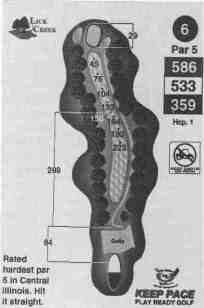
15. Lick Creek Golf Course
Pekin Park District
2210 N. Parkway Drive,Pekin
309/346-0077
#6 — Par 5, 586 yards
It's been rated the hardest par 5 in central Illinois and accuracy, rather than
how far can you drive the ball, is the key. From the white tees, the ball must
carry approximately 100 yards to clear the ravine and then another 60 to reach
the fairway From the blue tees the distance to clear the ravine is approximately
160 yards and then again another 60 to the fairway The landing area is very
narrow. Most golfers feel that if they place the tee shot in the fairway the hole
gets easier, but it does not. The landing area for the second shot is even more
narrow than the tee shot. The third shot is to an elevated green that measures
5,500 square feet with bunkers left, right and back left of me green. (The
green was rebuilt in 1997, making the bunker on the right smaller and adding
a bunker on the back left corner.) There is also a large ravine that runs the
entire length of the hole on the left side and another on the right side that
comes into play on the tee shot. Most low handicap golfers play a long iron off
the tee and then a mid- to long-iron on the second shot, leaving a high iron to
the green. Again, the key is to just keep the ball in play There have been many
a double figure counted here for the person who tries to be overly aggressive.
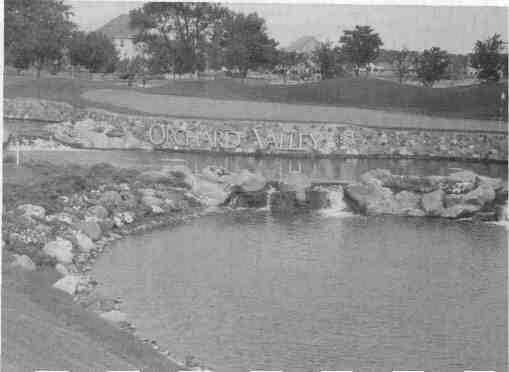
16. Orchard Valley Golf Course
Fox Valley Park District
2411 W. Illinois Avenue, Fox Valley
630/907-0500
#12 — Par 3, 155 yards
Nicknamed "Beauty and the Beast," this hole is both. While you
stand there at the tee, admiring the view and saying "such a pretty
hole," you're not checking the wind or noticing that the green has
two sharp tiers.
Anything other than
a well hit iron
quickly brings out
the beast. Orchard
Valley's magnificent
6,745-yard championship layout was
designed by Ken
Kavanaugh.
March/April 1999 ¦ 33
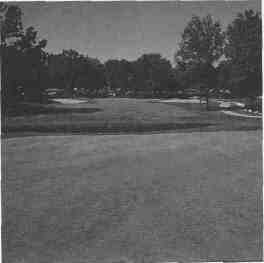
17. Rend Lake Golf Course
Rend Lake Conservancy District
12476 Golf Course Drive, Whittington
618/629-2353
#18 — Par 4, 425 yards
At 425 yards, a strong tee shot is
required to have a mid- to short-iron
into a thin, well-bunkered green. The
tee shot is particularly challenging in
that hidden water guards the left and a
deep bunker guards the sight of any
attempt to go for distance on the drive.
During the 1998 Illinois State Amateur
Championship held at Rend Lake last
September, many players chose to play
an iron from the tee, taking the hazards
out of play but leaving a long approach
to what can be a difficult green.
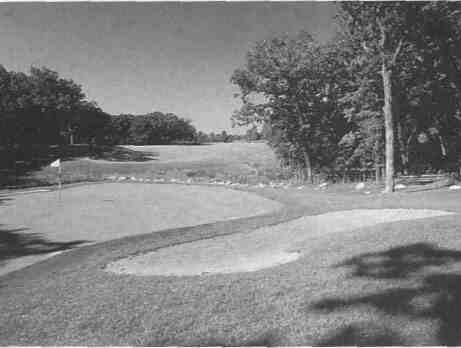
18. ThunderHawk Golf Club
Lake County Forest Preserve District
39700 North Lewis Avenue, Beach Park
847/872-HAWK
#18 — Par 5, 600 yards
Robert Trent Jones Jr. describes the finishing hole he designed for ThunderHawk as "very challenging, yet beautiful...very long and surrounded by an amphitheater of oak trees." No. 18 is a dogleg
left 600-yard par 5 with a very generous landing area. Tee shots should favor the right side of the
fairway. A good layup will leave you 150 to 170 yards away from a medium-sized green that is set
among trees with wetlands short of the green and bunkering to the right. The small sundrop, once
an endangered plant, grows on either side of this fairway and is protected by a small split-rail fence.
On this hole, Bruce Charlton, an architect with Robert Trent Jones II International, says: "Brutal
length, but downwind with great framing by existing forest...rock-lined creek is a great fortress to
green in beautiful setting."
34 ¦ Illinois Parks and Recreation















